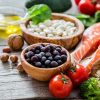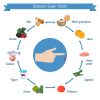Indian food is never complete without dal. It’s almost the backbone of our diet. In fact, we are the largest producers and consumers of lentils. As is the case with lentils, dal is high in nutrition and is a major source of protein for both vegetarians and meat eaters. Adding dal to your diabetes diet plan improves the nutritional value, and fulfils your recommended daily allowance.
Whether it is fried, cooked, or steamed, dal is rich in nutrients and can be cooked with a variety of vegetables and spices. Dal made from lentils like tuar, moong, Bengal gram, and others have:
- Essential amino acids
- Complex carbohydrates that are good for people with diabetes
- Low fat content
- Copious amounts of dietary fiber
- Vitamins and folic acid
Bengal gram benefits
It has been scientifically proven that consumption of Bengal gram regulates the digestion of carbohydrates. This means that the time taken for your blood sugar levels to shoot up after a meal increases – meaning reduced postprandial blood sugar levels.
One can consume this in the form of sprouts, or cook it.
With high protein content and digestion-resistant carbohydrates, Bengal gram is a great option to be included in your diabetes diet plan.
Calories in Cooked dal (100 gm.)
(Bengal Gram)
| Calories | 90.45 Kcal |
| Protein | 4.68 gm. |
| Fat | 3.24 gm. |
| Saturated Fat | 0.11 gm. |
| Carbohydrates | 10.18 gm. |
| Fiber | 3.45 gm. |
| Sodium | 5.02 mg. |
| Potassium | 220.40 mg. |
| Calcium | 13.85 mg. |
| Iron | 1.48 mg. |
| Zinc | 0.80 mg. |
Vitamins in Cooked Dal (100 gm.)
(Bengal Gram)
| Vitamin B2 | 0.03 mg. |
| Vitamin B6 | 0.04 mg. |
| Vitamin B9 | 38.93 μg. |
| Carotenoids | 425.58 μg. |
| Vitamin D2 | 0.51 μg. |
















